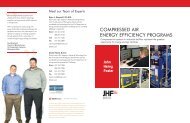The Turbo Air® 3000 Centrifugal Compressor Compressor Handbook
The Turbo Air® 3000 Centrifugal Compressor Compressor Handbook
The Turbo Air® 3000 Centrifugal Compressor Compressor Handbook
Create successful ePaper yourself
Turn your PDF publications into a flip-book with our unique Google optimized e-Paper software.
Maintenance<br />
Additional Maintenance Procedures<br />
In addition to periodic inspections and maintenance of the filter and lubrication systems, some<br />
maintenance will also be necessary on an “as required” basis. <strong>The</strong> necessity is determined by particular<br />
performance indicators or is performed on a periodic basis. Table 5—6 lists these procedures.<br />
Instructions for each follow.<br />
Other Maintenance Procedures<br />
Procedure: When Required:<br />
Intercoolers/aftercooler cleaning* With elevated interstage air temperatures<br />
Oil cooler cleaning* With intercooler service — or —<br />
With elevated oil temperature<br />
Discharge air check valve inspection At 6 month intervals<br />
*Indicated procedures require the use of commercial products available through the Cooper<br />
<strong>Turbo</strong>compressor Parts and Service Department. Refer to the specific procedures and Section Seven,<br />
Parts and Service, for more information about these products.<br />
Table 5—6 Other Maintenance Procedures<br />
Heat Exchangers<br />
A decrease in heat exchanger performance is an indication that it may be necessary to clean the intercoolers,<br />
aftercooler and/or the oil cooler.<br />
<strong>The</strong> best indicator of the performance level of the intercoolers and aftercooler is the approach temperature.<br />
This is defined as the difference between the temperature of the air leaving the heat exchanger<br />
and that of the water entering the heat exchanger. Record that information for all heat exchangers<br />
when the compressor is first installed and running at full load. When an approach temperature increases<br />
by 15°F - 20°F (8°C - 11°C) above the original level, or when an Alarm condition occurs as a<br />
result of high interstage temperature, that is an indication that it is time for cleaning.<br />
In the case of the oil cooler, however, the approach temperature cannot be used to determine a decrease<br />
in cooling capacity. <strong>The</strong> oil cooler should be cleaned whenever the intercoolers and aftercooler<br />
are cleaned, or when the compressor goes into an Alarm condition as a result of high oil temperature.<br />
Other factors may also sometimes contribute to decreasing heat exchanger performance. <strong>The</strong>refore,<br />
before cleaning the heat exchangers:<br />
· Be sure that they are getting the required water flow.<br />
· Be sure that the oil and air resistive temperature detectors (RTD’s) are functioning properly.<br />
· Be sure that the condensate drains are functioning properly.<br />
When it becomes apparent that cleaning is necessary, keep in mind that separate techniques are<br />
utilized for different parts of the heat exchangers:<br />
5—17



